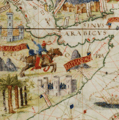Ajuran Sultanate facts for kids
Quick facts for kids
Ajuran Empire
Dawladdii Ajuuraan
دولة الأجورانية |
|||||||||||
|---|---|---|---|---|---|---|---|---|---|---|---|
| 13th century–late 17th century | |||||||||||
|
Flag
|
|||||||||||
| Capital |
|
||||||||||
| Common languages | Somali · Arabic | ||||||||||
| Religion | Sunni Islam | ||||||||||
| Government | Monarchy | ||||||||||
| Sultan, Imam | |||||||||||
| History | |||||||||||
|
• Established
|
13th century | ||||||||||
|
• First Ajuran-Portuguese war
|
1538–57 | ||||||||||
|
• Second Ajuran-Portuguese war
|
1580–89 | ||||||||||
|
• Oromo invasion
|
Mid-17th century | ||||||||||
|
• Decline
|
late 17th century | ||||||||||
| Currency | Ajuran • Mogadishan | ||||||||||
|
|||||||||||
| Today part of | |||||||||||
The Ajuran Empire (Somali: Dawladdii Ajuuraan, Arabic: دولة الأجورانية), also spelled Ajuuraan Empire, and often simply as Ajuran, was a Somali empire in the medieval times that dominated the Indian ocean trade. They belonged to the Somali Muslim sultanate that ruled over large parts of the Horn of Africa in the Middle Ages. Because of their centralized administration and strong military, they were able to resist an attack by the Ottoman empire. This was called Gaal Madow. The fought a number of wars with the Portugese, and were able to withstand them. After the war, trade routes were re-established or strengthened. In the coastal provinces, trade flourished. Ships sailed to and came from many kingdoms and empires in East Asia, South Asia, Europe, the Near East, North Africa and East Africa.
The empire was very important, and built many castles and fortresses. Some of them can still be seen, mostly in the southern part of Somalia. There are also a number of pillar tombs, necropolises, and cities built during that era, which are now in ruins, which are attributed to Ajuran engineers. During the Ajuran period, many regions and people in the southern part of the Horn of Africa converted to Islam because of the theocratic nature of the government. The royal family, the House of Garen, expanded its territories and established its hegemonic rule through a skillful combination of warfare, trade linkages and alliances.
The Ajuran also controlled the water resources. They built wells and cisterns on the rivers Shebelle and Jubba. Many of these wells are still working. The rulers also developed a new system of agriculture and taxation, which were used in parts of the Horn of Africa until the 19th century. The later rulers of the Ajuran were not as successful: There were rebellions, and by the late 17th century the empire had fallen apart into a number of smaller states. The most prominent of these was probably the Geledi Sultanate.
Images for kids
-
The city of Merca was one of several prominent administrative centers of the Ajurans.
-
The Jubba River
-
The walled city of Mogadishu on the 16th century Miller Atlas.
-
Mogadishu imported valuable gold Sequin coins from the Venetian Empire in Europe.
-
The Ajuran Empire maintained commercial ties with the Ming dynasty and other kingdoms.
-
Medieval city of Barawa
-
14th century Somali-Arabo stone tablet
-
Somali merchants from Mogadishu established a colony in Mozambique to extract gold from the mines in Sofala.
-
Model of a medieval Mogadishan ship
-
The Ottomans regularly aided the Ajurans in their struggles with the Portuguese in the Indian Ocean.
-
During the Battle of Barawa, Tristão da Cunha was wounded and requested to be knighted by Albuquerque.
-
In 1698, the Portuguese in Mombasa surrendered to a joint Somali-Omani force.
-
Somali maritime enterprise took a significant hit after the collapse of the Ajuran Empire. However, other Somali polities such as the Warsangali Sultanate, the Geledi Sultanate, the Majeerteen Sultanate, the Dervish state and the Sultanate of Hobyo ensured its continuity.
See also
 In Spanish: Sultanato Ajuran para niños
In Spanish: Sultanato Ajuran para niños




















